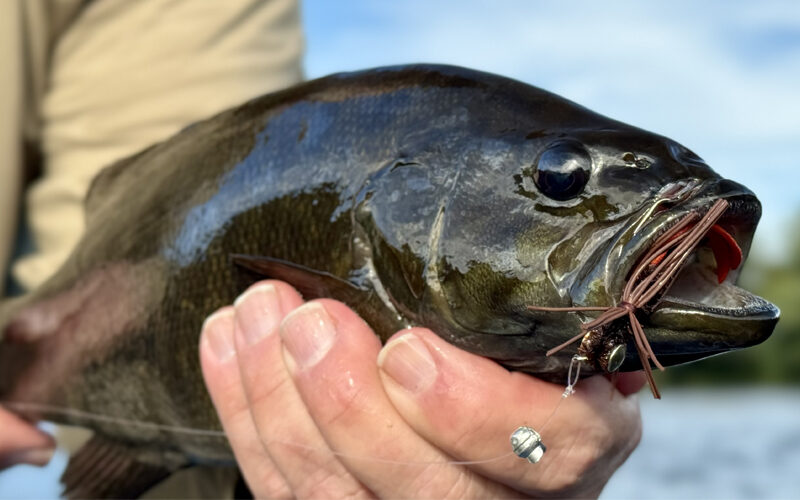
Dr. Peter Brookes
New River: Located in Southwest Virginia, the New River is considered North America’s oldest river, and one of the world’s oldest rivers, second only to Egypt’s Nile.
Also notable, the New flows northward, rather than southward, on its journey from its headwaters in North Carolina’s Blue Ridge Mountains into Virginia and then on into West Virginia; most East Coast rivers flow in a southern direction. But most importantly for the angler, the New is one of the best rivers in Virginia for fishing, boasting populations of nearly every major freshwater gamefish in the state; some consider the smallmouth bass fishing world-class.
Besides smallmouth, the New River boasts spotted bass, largemouth bass, rock bass, striped bass, hybrid striped bass, musky, walleye, black crappie, channel catfish, flathead catfish, yellow perch, panfish, and carp.
Jackson and James Rivers: Let’s begin with the Jackson River. In the western part of the state, the Jackson is generally divided into two sections: the portion above Lake Moomaw and the tailwater portion below Gathright Dam, which releases cool water into the Jackson below the lake.
The river provides excellent fishing for smallies, rock bass, rainbow trout, and brown trout above Lake Moomaw. Below the dam, the tailwater has wild (!) rainbow trout, wild brown trout, smallmouth bass, rock bass, and panfish.
Before fishing the Jackson, it’s best to be aware of special rights given to some landowners on the river below the dam to avoid straying into areas that are off-limits to anglers as well as possible legal jeopardy.
The James River, Virginia’s largest river, flows for some 300 miles from the Appalachian Mountains through the capital of Richmond and into the Chesapeake Bay. The “Big Jim” has both tidal and non-tidal sections.
In the non-tidal section (aka the upper and middle sections), the James flows from the confluence of the Jackson and Cowpasture Rivers to the 14th Street Bridge in Richmond, where the river’s fall line begins. These upper and middle sections offer great fishing including, smallmouth bass, spotted bass, largemouth bass, musky, channel catfish, blue catfish, flathead catfish, blue catfish, carp, and panfish.
The chance of netting a monstrous musky and or a big blue (some exceeding 50 lbs.) is a huge draw.
The tidal section of the river offers some terrific fishing in the spring, especially in April, with the annual shad and striped bass runs into the James River from the Atlantic Ocean on their spawning runs. Go out and get yourself a James River Slam of shad, stripers, and perch.
Shenandoah River: Flowing through the scenic and historic Shenandoah Valley, the main stem of the Shenandoah River is formed at the confluence of the North and South Forks at Front Royal before dumping into the Potomac River at Harper’s Ferry, West Virginia.
The Shenandoah, especially the North and South Forks, is renowned for its citation-sized smallmouth bass fishing. Two fish per hour is a common catch rate, but in a good recruitment year, boating 50 to 100 bass on a summer float trip isn’t uncommon.
The Shenandoah system also contains largemouth bass, channel and flathead catfish, panfish, walleye, crappie, carp, and musky. During river surveys, DWR fisheries biologists have come across several female musky exceeding 50-inches.
Tuna Action Closed at Nags Head
Looks like no more tuna fishing from Jennette’s Pier. An organization called NOAA (National Oceanic and Atmospheric Administration) called a halt to any form of tuna fishing from the pier or shore because the bluefin recreational quota had been reached in federal waters. But Jennette’s Pier and the shoreline of Nags Head aren’t in federal waters, so the NOAA had no jurisdiction, but when does that stop bureaucrats?
NOAA, headquartered in (you guessed it) Washington, DC has 321 federal and 12,000 civilian employees. Their budget is $6.9 billion (billion with a “b”). They are the consummate federal bureaucracy – unelected busy bodies that simply make up the rules as they go along. In a similar situation just 2 years ago, NOAA said such a catch was allowable. But they changed their minds.
Local fishing advocates view this response as an overreach—one that punishes recreational fishermen operating legally and ethically under state rules simply because federal data reflected a regional quota being exceeded. They argue it was also an overstep of the agency who should have handled the case, North Carolina Division of Marine Fisheries, who oversees state waters.
What happened at Nags Head was a rare event and a handful of recreational anglers had a once-in-a-lifetime chance to hook up with a bluefin tuna without spending $3,000 for an ocean charter. Leave it to a government bureaucracy to put an end to an otherwise remarkable occasion.
DOGE and Elon Musk, could you please take a closer look at the $6.9 billion National Oceanic and Atmospheric Administration?

